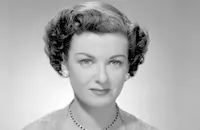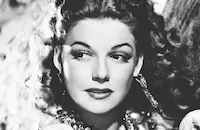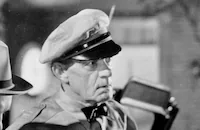Mississippi
Brief Synopsis
Cast & Crew
A. Edward Sutherland
Bing Crosby
W. C. Fields
Joan Bennett
Gail Patrick
Queenie Smith
Film Details
Technical Specs

Synopsis
In the antebellum South, Commodore Orlando Jackson is the bumbling, drunken captain of the Mississippi showboat The River Queen . One night he takes the show on land to General Rumford's plantation to entertain at an engagement party at which Rumford's daughter Elvira will announce her engagement to Tom Grayson, his ward. The gathering is interrupted by Major Patterson, a former suitor of Elvira. He protests the engagement on the grounds that they were previously engaged, and challenges Tom to a duel. Tom, who is an Easterner, refuses to duel over petty jealousy, but loses the respect of Elvira and Rumford for not conforming to Southern custom. He is asked to leave, and as he is departing, Rumford's youngest daughter Lucy confesses to being in love with him. Despite her beauty, Tom does not take her seriously because she is young. He signs a contract with Jackson to sing on the showboat. During one of Jackson's many card games, Tom saves his employer's life by preventing an angry gambler from knifing him. Jackson is grateful and uses this incident to save himself from Captain Blackie, to whom he owes money. Jackson invents a character named Colonel Steele, "the singing killer," and tells Blackie that Tom is Steele. During Tom's performance that night, Blackie attempts to stop the show, threatening to kill Tom. Tom becomes angry, interrupts the show and fights with Blackie, killing him with his own gun. After this, Jackson, a teller of tall tales, advertises that his show stars the notorious Steele, and Tom seems to take the personal attributes that suit the character. Tom acquires great fame, and by the time he meets Lucy again, she has grown into womanhood. They fall in love, but when she discovers he is the Colonel Steele who reportedly killed her cousin, she leaves him and returns home. Tom later receives a letter from Lavinia, Lucy's maid, informing him Lucy is engaged to be married. He goes to the plantation and successfully intimidates both Major Patterson and Lucy's fiancé, thus regaining Rumford's admiration. After realizing the Steele story is a lie, Lucy happily returns with Tom to the showboat.

Director
A. Edward Sutherland
Cast

Bing Crosby

W. C. Fields

Joan Bennett

Gail Patrick
Queenie Smith

Claude Gillingwater

John Miljan
Fred Kohler Sr.
Edward Pawley
Theresa Maxwell Conover
Paul Hurst
John Larkin
Libby Taylor
Jan Duggan
The Cabin Kids

Harry Myers

King Baggott
Mahlon Hamilton
Albert Richman
Francis Mcdonald
Stanley Andrews
Eddie Sturgis
George Lloyd
Bruce Covington
Jules Cowles
Clarence Geldert
Charles L. King
J. P. Mcgowan
Harry Cody
Forrest Taylor
Bill Howard
Victor Potel
Jack Mulhall
Jack Carlyle
Richard Scott
Arthur Millett
Clarence L. Sherwood
Bert Lindley
Fred "snowflake" Toones
Matthew Betz
Warner Richmond

James Burke
Jean Rouverol

Ann Sheridan
Mildred Stone
Mary Ellen Brown
Mabel Van Buren
Roy Bailey
Warren Rogers
Dan Crimmins
William Gould
Jean Clarendon

Lew Kelly
Crew
Claude Binyon
Irvin S. Cobb
Jack Cunningham
Hans Dreier
Herbert Fields
Herbert Fields
Stephen Foster
Lorenz Hart
Bernard Herzbrun
Arthur Hornblow Jr.
Chandler House
Charles Lang
Francis Martin
Eugene Merritt
Richard Rodgers
Wesley Ruggles
Dore Schary
Karl Struss
Adolph Zukor

Film Details
Technical Specs

Quotes
Trivia
Notes
A pre-release article in Motion Picture Herald attributes the screenplay to credited writer Herbert Fields and Hugh Wiley, who wrote black stories for The Saturday Evening Post. However, a pre-release article in Hollywood Reporter indicates that Henry Myers was signed to develop this story. According to news items in Hollywood Reporter, director Wesley Ruggles took over direction of some scenes due to Sutherland's illness; however, Sutherland returned to complete the film. According to a press release, Karl Struss began as cameraman on this film. Modern sources state that he was pulled from this film to photograph a Mae West picture (presumably Goin' to Town. A production still shows Struss on the set of Mississippi. An advertisement for the film billed The Cabin Kids as "Those Ethiopian Quintuplets...five sun-tanned, rhythm-shouting scamps." According to the press book, the children-Ruth, 11; Helen, 10; James, 9; Winifred, 6; Fred, 4-were taught by their stepmother Mrs. Beatrice Hall. A black chorus backed Bing Crosby's "Swanee" number. The pressbook notes Eugene Merritt supervised the recording of Crosby's films. An article in Variety notes that the "Crosby part was written with Lanny Ross in mind." The article also mentions that Molasses and January, the radio comedy team, are billed in reviews but do not appear in the film. New York Times notes that much of W. C. Fields's performance was ad-libbed, including a number with a calliope. Other films based on Booth Tarkington's play are Famous Players-Lasky's 1924 The Fighting Coward, directed by James Cruze and starring Ernest Torrence and Mary Astor, and the 1929 River of Romance, directed by Richard Wallace and starring Charles "Buddy" Rogers and Mary Brian (see AFI Catalog of Feature Films, 1921-30; F2.1710 and F2.4635). A modern source notes that some of the card tricks and Indian stories used in this film were also used in My Little Chickadee (see below).












